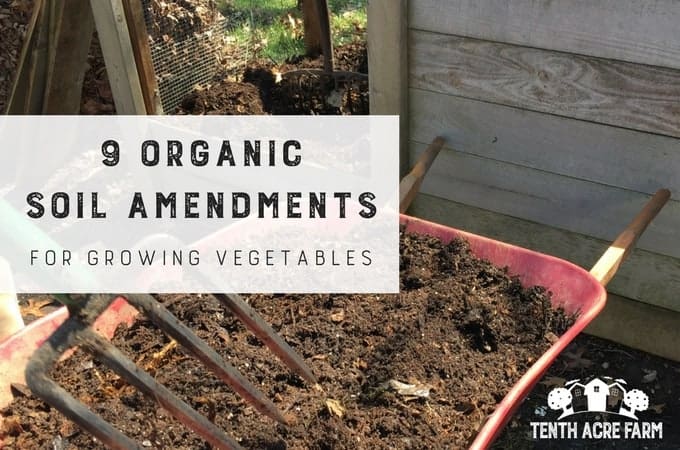9 Organic Soil Amendments for Growing Vegetables
Do you have soil that’s high in clay or sand? Here are some of my favorite organic soil amendments that can improve conditions for growing vegetables.


This page may contain affiliate links. Please read my disclosure for more info.
Gardeners often complain about having unworkable clay soil or sandy soil in which nothing will grow. We tend to think that our plight is totally unique compared to all of those *lucky* gardeners out there who naturally have perfect soil!
Truth is, the majority of gardeners have challenging soils that require improvement for cultivation. We are all special by not being unique! 🙂
Ideal garden soil will bring these two spectrums into balance. Loamy soil balances clay, sand, and organic matter. Organic soil amendments can help us do this.
Improving Soil Using Soil Amendments
Organic soil amendments can increase beneficial soil organisms, organic matter, and improve moisture retention.
The following list contains a variety of soil amendments from animal, mineral, and plant-based sources. Some items are free and easy to find locally, while you’ll have to purchase others.
In general, add soil amendments in the fall, or in the spring before planting the garden.
I’ve divided soil amendments into three categories: animal-, mineral-, or plant-based amendments.
Animal-Based Soil Amendments
Some animal-derived soil amendments can increase beneficial soil organisms in addition to improving soil structure. Apply untreated animal products nine months before harvest, or at a minimum of two weeks before planting.
Mineral-Based Amendments
Use mineral-derived soil amendments to correct mineral deficiencies. Mineral-based amendments do not break down easily, so they can be over-applied. That’s why it’s essential to get a soil test beforehand so you know what you need.
Plant-Based Amendments
Use plant-based soil amendments to improve soil structure. Because herbicide contamination can result in stunted growth and lackluster performance, it’s important to source herbicide-free amendments. Surprisingly, contamination can occur even if you don’t use herbicide in your garden and purchase organic-approved amendments.
Grow a garden that’s both productive and manageable with my Complete Garden Planning System, which includes practical tools for planning your season from seed to harvest.
Here are a few of my favorite amendments from each category:
1. Bat Guano (Animal-Based Amendment):
Bat guano is a fast-acting, organic fertilizer high in nitrogen and phosphorus, which promotes strong and healthy plant growth. It can also improve the texture of soil, improve drainage in heavy soils, and help to neutralize soil contaminants. By increasing beneficial bacteria in the soil, it helps to protect plants against disease.
Bat guano is highly concentrated, so a little goes a long way. As with other animal manures, mix into the soil in the fall, or at least two weeks before planting. This allows time for the nutrients to break down into a form that plants can absorb.
Note: This soil amendment is considered by many to be unsustainable, due to harvesting methods that may destroy cave habitat and negatively affect the health of bat populations. Although an excellent amendment, I recommend using caution and using many of the alternatives listed here.
2. Manure (Animal-Based Amendment):
Use livestock manure mainly as a slow-release fertilizer. That’s because it contains most of the elements required for plant growth including nitrogen and many other nutrients. It can also condition the soil, increasing beneficial soil organisms and moisture retention.
The manure can come from nearly any livestock animal, NOT dogs or cats. However, it’s often contaminated with herbicide. Read more about contaminated manure and the serious problems it can create.
Spread fresh manure at least 3-4 months before harvesting a crop to avoid potential pathogens. Spread it in the fall or one month before planting. This timing will prevent it from burning plants.
Although aged manure contains less nitrogen than fresh manure, this soil amendment makes an exceptional conditioner.
- Turn manure into the soil within 12 hours of the time of spreading to capture the nitrogen in the soil. This prevents it from leaching away.
- Do not spread fresh manure on ground that’s frozen or oversaturated by a recent rain.
- If heavy rain is in the near forecast, wait it out.
Many state laws include these common agricultural prohibitions, which reduces runoff from farm fields and helps to keep waterways clean. Plus, you don’t want all of your hard work and valuable nutrients to wash away!


Worm compost
3. Worm Compost (Animal-Based Amendment):
Worm castings are the richest fertilizer known to humans, and is high in minerals. This soil amendment is also high in nitrate, a more bioavailable source of nitrogen than that found in commercial fertilizers.
Worm castings help plants regulate water usage, improve soil structure, and increase plant vigor. You can even use worm castings in place of potting soil. There’s no upper limit to how much of this amendment you apply at one time.
Buy bagged worm castings or learn how to create your own worm castings in a worm bin. Be sure to check out these worm bin problems for beginners.
4. Greensand (Mineral-Based Amendment):
Greensand is a slow-release soil conditioner largely composed of glauconite, a mineral harvested from ancient forest floors. It’s considered high in potassium and trace minerals such as iron and magnesium.
The main benefit of this mineral, however, is loosening clay soil and improving moisture retention. Read more about improving clay soil.
Apply this soil amendment in early spring before planting.
Note: Do not confuse greensand with regular sand, which does not have the same benefit.
5. Comfrey (Plant-Based Amendment):
Comfrey is a perennial herb with large green leaves and purple, pink, or white flowers. This soil amendment is used in many ways to fertilize soil.
It can activate a compost pile due to its high nitrogen content. Use the chopped leaves as mulch around fruit trees and mature fruiting vegetable plants.
To use comfrey as a green manure in a vegetable garden, spread chopped leaves in the fall. Then gently incorporate them into the soil using a digging fork in the spring before planting.
My favorite variety is Russian comfrey because it doesn’t spread like true comfrey can. Learn more about growing comfrey to get the most out of this useful, biomass-producing plant.
Comfrey powder is a great way to fertilize a garden bed in the spring before planting. Learn more about the many uses of comfrey in the permaculture garden, including how to make comfrey powder.
6. Compost (Plant-Based Amendment):
Homemade compost made from food scraps and yard waste is an inexpensive, slow-release fertilizer and soil conditioner for the garden. It’s also a great way to keep household waste out of the waste stream.
However, it’s important to know how to keep persistent herbicides out of your compost bin, even if you don’t use herbicide in your garden.
As a matter of fact, herbicides can even contaminate commercially made soils that are approved for Organic agriculture! Learn 5 essential questions to ask a producer before buying compost soil for your garden.
Got a compost pile that’s slow to break down? This happens when there’s not enough nitrogen, or green matter, which is common in backyard compost systems. Get your compost heating up with this organic-certified compost accelerator.
Homemade compost improves soil structure by aerating, improving drainage, and retaining moisture retention. Add 3-4 inches of this soil amendment each spring before planting and work it in with a digging fork.
For perennials, spread compost annually around trees and shrubs without working it into the soil.
Read more about 6 ways to build a compost bin.
Would you like to learn more about using natural amendments to improve the quality of your soil, reduce maintenance, and increase yield?
You’ll find loads of information just like this in my award-winning book, The Suburban Micro-Farm.
7. Cover Crops (Plant-Based Amendment):
Cover crops increase soil fertility, improve soil texture, and increase beneficial soil organisms and fungi. All of these benefits together can help to reduce pests and disease. Sow this “soil amendment” in garden beds in the fall, about four weeks before the frost date.
Overwintered, by springtime cover crops are full and lush, outcompeting early spring weeds. When they begin to flower or set seed heads, cut them back just above the soil line. After a couple of days, incorporate the “green manure” into the soil with a digging fork, breaking up roots.
Many micro-farmers use livestock such as chickens to help turn cover crop residue into the soil.
Wait three weeks before planting in the bed.
There are many kinds of cover crops. The mixture that’s right for you will depend on your local climate and your goals. If your garden is a no-till garden, avoid grass-type cover crops since they will be a challenge to hand-turn into the soil.
Your local extension office can help you choose appropriately. Try clay-busting plants!
When cover cropping, alternate keeping a few garden beds for overwinter vegetable production, while planting the rest in cover crops.


Leaf mold
8. Leaf Mold (Plant-Based Amendment):
This soil amendment is effective as a water-retaining mulch or soil conditioner. In fact, “Pound for pound, the leaves of most trees contain twice as many minerals as manure.” Fall leaves are both a valuable mulch and soil builder.
Leaf mold is simply leaf mulch that has aged for two to three years. It can benefit the garden in many ways. The consistency of leaf mold lies somewhere between shredded leaves and leaves that have composted completely into humus.
When hot weather strikes, lay leaf mold over the garden as mulch, keeping it away from the stems of plants. It has a cooling effect on soil. As the mulch breaks down, it will attract beneficial soil organisms while transforming into humus.
To make leaf mold, shred the leaves first by running over them with a lawnmower, or by using a leaf mulcher.
To make “quick” leaf mold, make a rectangular pile of shredded leaves, 5 feet square by 5 feet high. Turn the pile monthly, and you might be able to make leaf mold in as little as 12 months, though the process usually takes a couple of years.
As a soil conditioner, add finished leaf mold to garden soil in the fall, then mix it in with a digging fork in the spring before planting.
9. Wood Chips (Plant-Based Amendment):
With the growing popularity of the film Back to Eden, gardeners are adding wood chips at an accelerated rate. However, it’s important to know how to use this soil amendment correctly.
Adding wood chips is like mimicking the forest floor, where leaves and twigs naturally decompose on top of the soil. Wood chips increase organic matter, improve nutrient levels, and increase the numbers of beneficial soil organisms as they break down.
They hold in moisture, reducing irrigation needs. Covering the ground, they reduce weeds. Wood chips create a stable growing environment by insulating against the hot summer sun and freezing winters.
Use wood chips as mulch rather than tilling or mixing them into the soil.
To use wood chips in the vegetable or perennial garden, age them for two or three years before mixing them into garden soil as an amendment, and add a teensy amount of blood meal with them to make up for lower nitrogen availability.
Or lay fresh wood chips on top of the soil as mulch without mixing them in.
I prefer to use wood chips in the pathways of my vegetable garden. That’s because beneficial soil organisms and fungi will enjoy plowing through my beds between the pathways.
Tree trimmers often deliver wood chips for free. For example, I have access to an arborist who delivers a trailer-load for a $20 fee.
Summary
Focus on increasing soil life and soil structure to help your growing conditions. First, focus on those soil amendments that you can make for free. They will often have the biggest impact because they will jumpstart biological activity.
Later, if you choose to add a store-bought amendment, such as greensand, you can purchase less of it. This will maximize the efficiency of your efforts and reduce your micro-farming costs, too.
Resources:
Whether your challenge is sandy or clayey soil, these amendments will help improve your gardening success.
What type of soil do you deal with? What soil amendments have helped improve it?
READ NEXT:
>>> Get my free 19-page Guide to Organic Soil Amendments for more ideas:









